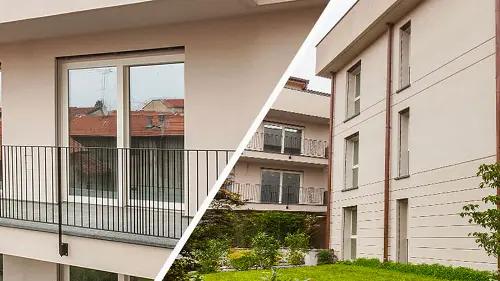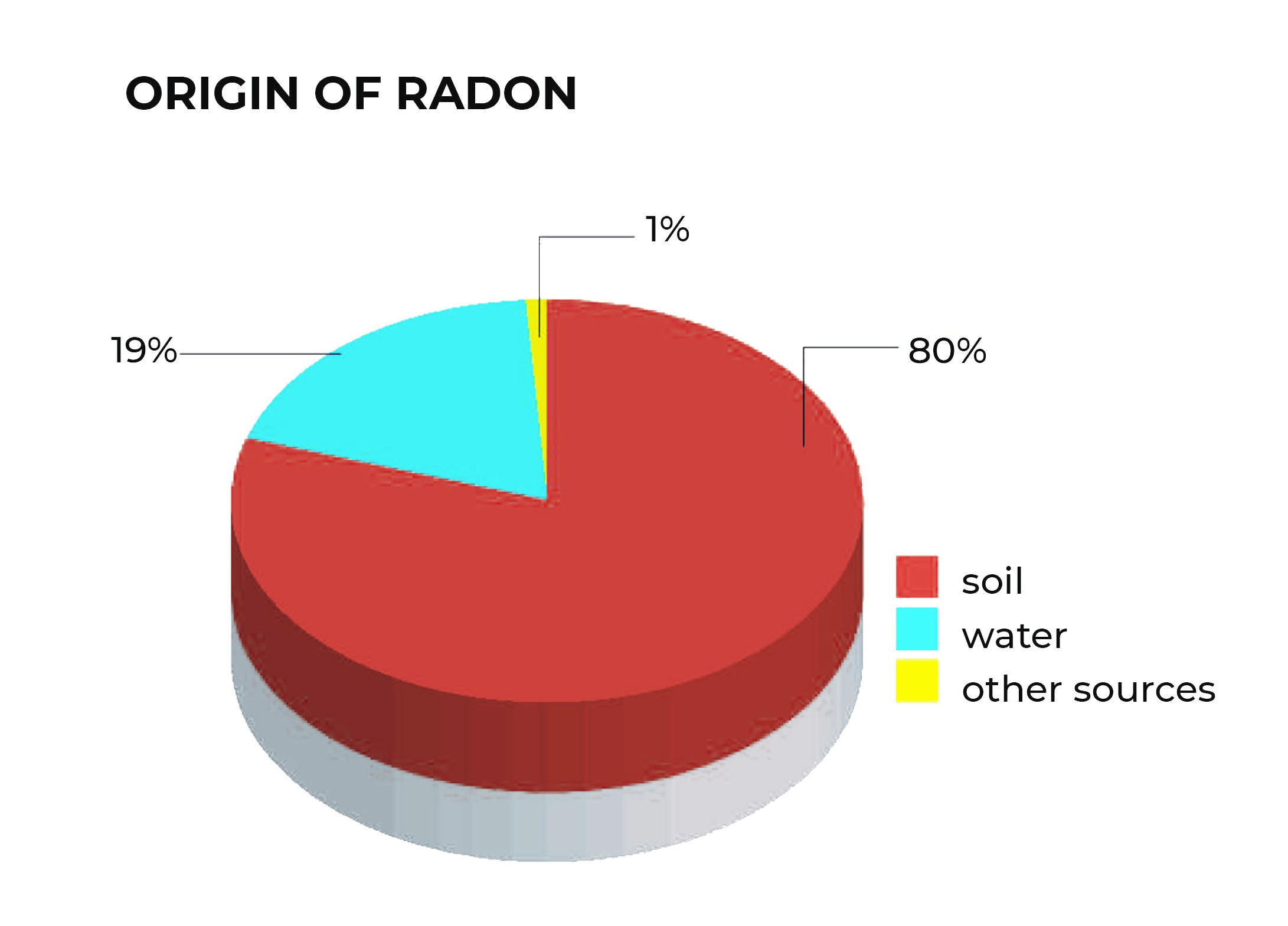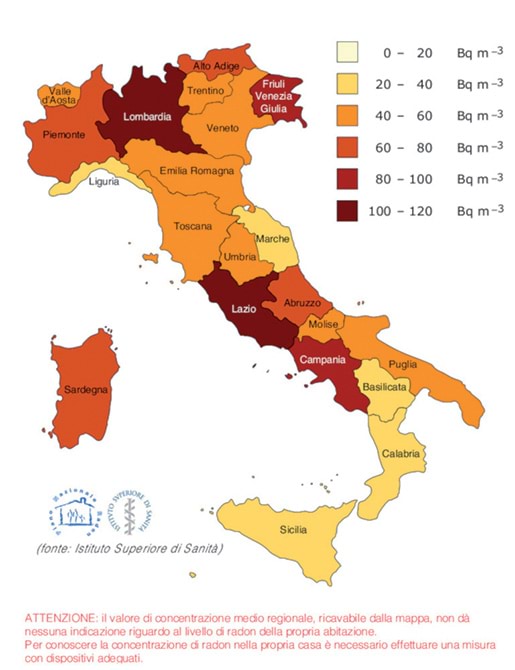
Natural radioactivity: Radon
Origin, risks and prevention: a talk with Giancarlo Ciotoli, Research Scientist at the Italian National Research Commission, Institute of Environmental Geology and Geo-Engineering.
Origin, risks and prevention: a talk with Giancarlo Ciotoli, Research Scientist at the Italian National Research Commission, Institute of Environmental Geology and Geo-Engineering.
Wherever we find ourselves, we are constantly “immersed” in ionizing radiation from space (cosmic rays), but it also hits us when we are outdoors, due to the decay of radioactive elements present in the rock from which the Earth is made, and inside our homes from building materials. Natural radioactivity is a lot more harmful than artificial radioactivity. In fact, natural radioactive sources are the main cause of our exposure to ionising radiation, which is known to be cancerogeneous. Radon (Rn) is one of the main sources of ionising radiation. Radon is a naturally-occurring radioactive gas that is part of the family of noble gases. It is odourless, colourless and tasteless, making it imperceptible to our natural senses, which is why it is so difficult to detect and quantify its presence unless special, highly sensitive instruments are used. And because it is naturally occurring and is an important component of the total level of ionising radiation, its potential danger is often underrated. In 2021, the World Health Organization estimated that radon is the main case of pulmonary neoplasms (between 3 and 14%) after cigarette smoke in every country, and that its level of risk depends mainly on the average national radon concentration level in homes and its synergic action with tobacco smoke.
Where does it originate?
Radon originates from the “nuclear decay” of its direct parent material, Radium (226Ra), which in turn is one of the main products in the chain of radioactive decay of Uranium (238U), an element widely diffused in small quantities throughout the whole of the Earth’s crust. The most common natural Radon isotope is Radon-222 (222Rn) which decays in just a few days, that is, its concentration halves in 3.82 days, giving off alfa-type ionising radiation (particles with two protons and two neutrons) and forming so-called decay products (the offspring, or progeny, of radon) which are also radioactive, such as Polonium, Lead and Bismuth.
Where is it found and how does it spread?
Uranium and Radium are solid elements that have been present in highly variable quantities in rocks since the formation of the Earth, which means they can also be found in construction materials derived from these rocks (cement, tuff, bricks, Pozzolan, granite, etc.). Radon can also be found everywhere on Earth, albeit in highly variable concentrations, but since it is the only gas in the decay chain, it is able to be released from grains of soil, move through pores in soil by diffusion and/or migrate along fracture zones (faults) for tens and hundreds of metres by advection (movement generated by pressure gradients) and, before giving origin to its decay products, it is released from the ground, from construction materials and from groundwater and, as a result, enters into buildings.
Once Radon is released from rocks and passes through the ground, it reaches the surface and quickly mixes with the atmosphere, where it can be found in concentrations of between 5 and 15 Bq/m3. The variation in concentrations of airborne Radon depends on an area’s physical parameters, such as morphology, or on meteorological parameters, such as atmospheric pressure, temperature, humidity and wind speed. Once it enters into buildings, the variability in radon concentration increases due to parameters determined by the construction characteristics of the building and by the lifestyle of its occupants.
Where is it present?
As mentioned above, the presence of radon at the surface is determined by the geological, structural and morphological characteristics of the territory which, in turn, depend on global dynamics and, therefore, vary from place to place.
Our planet has a large variety of different geological scenarios, which means radon concentrations, produced by rocks below ground that are then able to reach the surface, are not uniform and vary quite considerably, even within the confines of an apparently homogeneous territory. The largest contribution depends mainly on the lithological characteristics of the territory and the presence of certain rock types in particular that have a higher content of Uranium and Radon, such as effusive volcanic rocks (tuff, basalt, etc.). These rocks can release larger amounts of radon, with respect to the amount produced at a balanced state of Uranium and Radon concentrations, according to their permeability and fracture state. In fact, the presence of fractures and faults allows Radon present below the surface to migrate more quickly towards the Earth’s surface, giving rise to high concentrations of this gas in the ground. Radon can then spread from the ground into closed environments through faults and cracks in foundations and floors in basements, through cable and pipe runs, joints between floors and walls, etc., according to the structural characteristics of buildings. Rooms below ground level, therefore, are particularly at risk, especially if their walls have not been rendered.
Rocky materials used for construction purposes can also contain high concentrations of radionuclides (Uranium and Radon) and have a harmful level of radon emissions. Emission levels are that much greater the higher the concentration level of radon and the porosity of the materials. Particularly high Radon levels may be associated with certain types of Pozzolan cement, clay materials and/or tuff. In general, however, the contribution to emissions from well-sealed and/or well aired building materials
How do you measure Radon levels and where should they be monitored?
Even though it is possible to have an idea of the amount and estimate the presence of radon in the ground for quite large areas, it is more complicated to predict the precise concentration levels of this gas in a certain home, due to the extreme variability caused by factors such as climate and lifestyle. What is more, as already discussed, it is impossible to rely on our senses to detect the presence of radon. As a result, to measure the amount of radon present in a certain building, we have to measure the level of airborne radon using special measuring equipment.
Indoor radon levels are expressed in Bq/m3 (Bequerels per cubic metre). For example, a concentration of 100 Bq/m3 means 100 radon atoms disintegrate every second in 1 m3 of the material or air being measured.
To obtain a meaningful measure of the average level of radon we are exposed to within the confines of a habitation, we also have to take into consideration how radon concentration varies, not only between different zones of a certain territory and from home to home, but also over time due to numerous meteorological and lifestyle factors that have an effect on this phenomenon. The presence of radon in a closed environment varies constantly, both in the arc of a single day (levels are generally higher at night than during the day) and from season to season (concentration levels are normally higher in winter than in summer), which means it is important to monitor levels for a lengthy period of time, generally a whole year. In this case, measurements can be taken in one or more consecutive campaigns, depending on the type of instrument used.
In general, the level of radon varies between one floor and another of a building: at the lower floors and those below ground level, where there is closer contact with the ground, there will probably be higher concentrations of radon. For habitations on one level it is sufficient to measure a single room, while for habitations on more than one level, it is possible to take a single measurement at the lowest inhabited level, or at each level if you also wish to measure the effect of construction materials. In general, the rooms that need to be taken into consideration when measuring the level of radon in a building are those most used, while bathrooms, kitchens, utility rooms, garages and basements are generally excluded.
What instruments are used to measure the concentration of Radon in a room?
Two types of instrument may be used to measure the level of radon in a room: passive instruments and active instruments. Passive instruments (dosimeters) are small devices and do not need a mains supply. They supply an average value of airborne radon concentration over the period of time of exposure. Passive dosimeters consist of a plastic casing containing an element sensitive to radon (trace or electric-field detector). This type of instrument does not give off any substance or radiation. The dosimeter is placed in a room for a specified period of time. At the end of this period, it is sent to a laboratory which analyses the trace and then sends back the results. In particular cases, in agreement with trained personnel, active dosimeters may also be used to read levels over a shorter period of time and for monitoring on a continuous basis, such as to plan and/or evaluate the effectiveness of clean-up operations in buildings with high levels of radon. The principle of this type of instrument is based on the taking of a sample of the indoor air and measuring the level of radiation given off by the radon contained in the air.
What is the risk of Radon?
Because it is so widespread, radon presents the highest risk amongst ionising radiation sources to people. Since Radon is a non-reactive noble gas, once it is inhaled it is not deposited in the lungs, but quickly expulsed with negligible effect on radioactivity in the lungs. The harmful side-effects of Radon are mainly due to the by-products of decay: solid, α-emitting radioactive elements (Po-218 e Po-214). These elements, which at the same time are present in the air, can become attached to airborne dust or to particles of smoke and then be inhaled or swallowed and deposited in bronchial or pulmonary tissue, where they give off significant doses of α radiation.
While human skin is not particularly sensitive to α radiation, the same cannot be said for the cells of the tissues of our internal organs, especially bronchial and pulmonary tissues, which are highly sensitive to these particles and the level of damage that occurs depends on the intensity and duration of exposure. The different radioactive substances produced by the decay of Radon, therefore, can enter our body, reach the internal organs and remain there for a long time, constantly giving off their radiation and, as a result, damaging our health.
The level of airborne concentration of products from the decay of Radon reaches its maximum level after a sufficiently long period of time if there is a total lack of ventilation, as soon as radioactive equilibrium is reached between the products of decay and their “parent” Radon. The probability of damage occurring as a result of exposure to a specified concentration of airborne Radon is proportional to the product of Radon activity concentration, in Bq/m3, multiplied by the period of exposure.
In 1988 the World Health Organisation (WHO), through the International Agency for Research on Cancer (IARC), declared that radon is one of the 75 substances cancerogeneous to people, along with benzene and asbestos. In 2008, a study carried out by the Italian Health Institute estimated that, in Italy, 3,200 people die every year of lung cancer caused by Radon, around 10% of the annual number of deaths due to lung cancer.
So what solutions can be adopted to mitigate, expel or block the passage of radon into our homes?
The main measures at the design stage are to insulate the ground, make sure air gaps and basements are well ventilated, to seal any gaps where gas could enter a building, make floor slabs impermeable and insulate cracks, pipes, etc. Choosing the right construction materials with low natural radionuclide content also reduces concentration levels.
To reduce radon concentration levels in existing buildings, on the other hand, unless large-scale renovation work is scheduled, technical measures can be taken to mitigate the problem, such as simple works aimed at reducing ingress of radon into the building and/or increasing the exchange and circulation of indoor air by introducing air from the outside.
Before deciding on which approach and system to adopt, it is necessary to gather as much information as possible about the building, such as the construction materials used, the characteristics of the ground and subsoil the building was built on and the type of foundations, existing air-conditioning and heating systems, whether it is possible to install extra ventilation and the presence of suitable ground drainage under the building.
In general, the measures to be adopted are:
• more ventilation in the rooms: this solution is very simple, but it does not allow the level of concentration to be reduced if it is particularly high;
• seal any routes where radon can enter: this should always be done because it helps reduce infiltrations of gas from the outside;
• with buildings that have crawl spaces, the most simple solution is to increase natural ventilation and, if that is still not sufficient, to install a forced ventilation system;
• for buildings with a foundation slab, you can depressurise the ground under the building by installing a radon well below or close to the building connected to an air extraction system.












